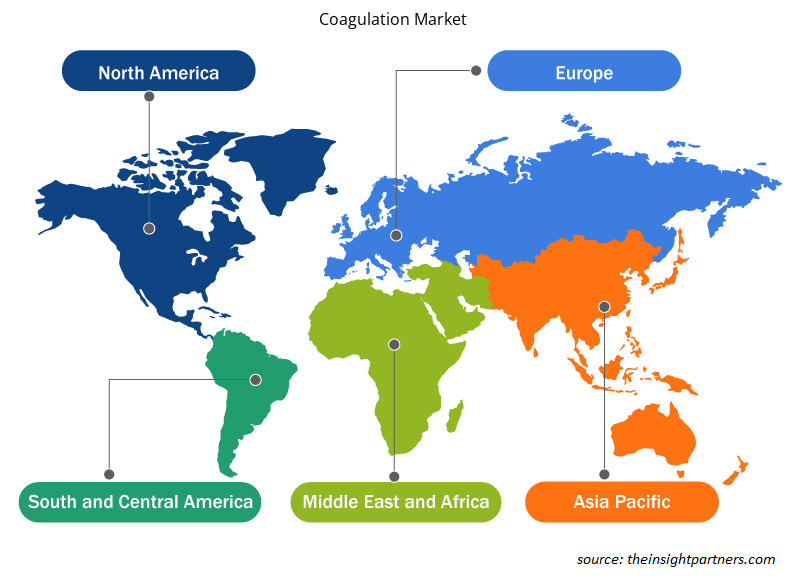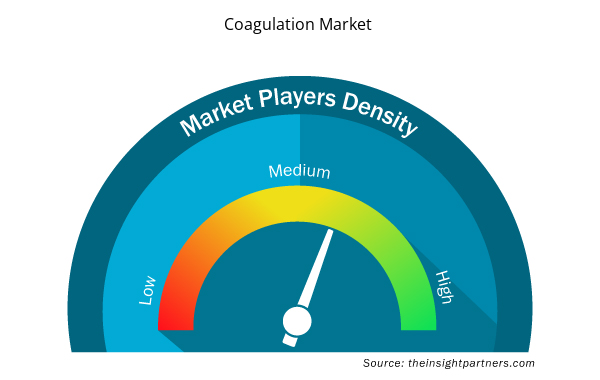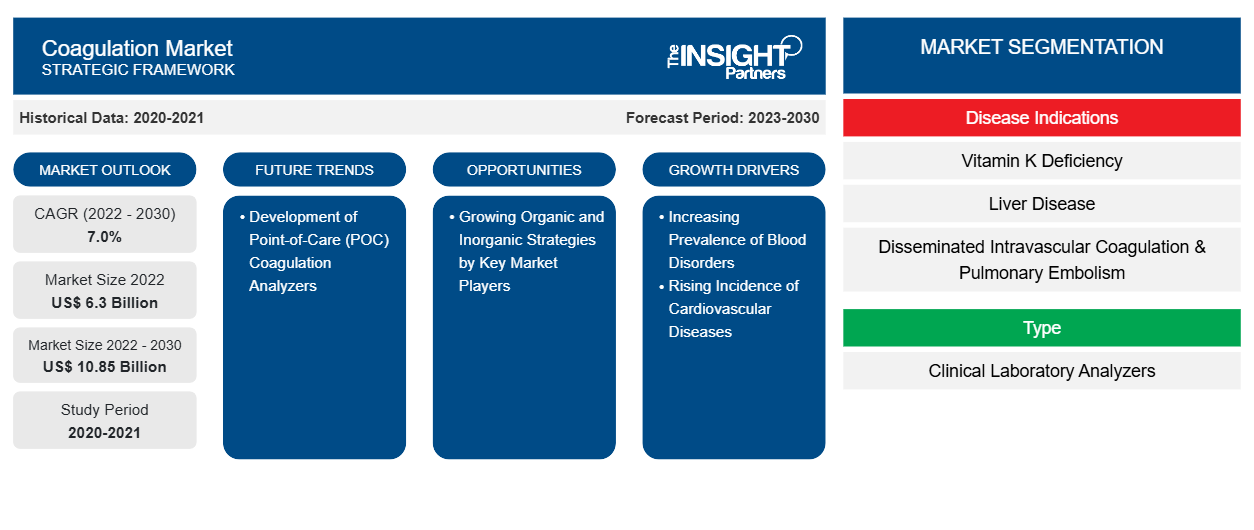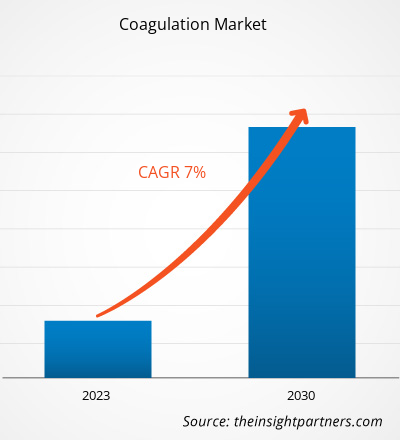[研究报告] 凝血市场预计将从 2022 年的 62.9528 亿美元增长到 2030 年的 108.5328 亿美元;预计 2022 年至 2030 年的复合年增长率为 7.0%。
市场洞察和分析师观点:
随着血液凝固和其他导致血栓的血液相关疾病病例的增加,凝血市场规模正在扩大。Medsafe 新西兰药品和医疗器械安全局估计,每年每 10,000 名服用口服避孕药的女性中,有 2-6 人面临血液凝固状况。抗凝药物,也称为血液稀释剂,主要用于预防和治疗血栓。住院期间服用血液稀释剂很常见,尤其是在诊断后的前 5-10 天,此时病情被认为是最严重或最急性的。但是,具有适当风险状况的人最初可能会被开具血液稀释剂供在家使用。此外,心血管疾病病例的增加(可能是由于心脏动脉血液凝固引起的)正在推动凝血市场的增长。
增长动力和挑战:
根据美国罕见疾病组织的数据,血友病 A 是一种常见的 X 连锁隐性遗传病,也是继血管性血友病之后第二常见的遗传性凝血因子缺乏症。此外,在美国,每 5,000 名男婴中约有 1 人患有血友病 A。根据 2020 年全球血友病护理研究,全球已发现并记录了 393,658 例出血性疾病病例,其中包括 241,535 例血友病病例、87,729 例血管性血友病病例和 64,394 例其他出血性疾病病例。根据美国国家医学图书馆 (NLM) 的数据,2020 年美国约有 30,000-33,000 名男性患有血友病。
根据美国癌症协会 (CLL) 的报告,美国在 2021 年记录了约 21,250 例慢性淋巴细胞白血病新病例。美国疾病控制与预防中心 (CDC) 在 2020 年 2 月的最新消息指出,美国受深静脉血栓影响的人数可能达到 900,000 人(每 1,000 人中有 1-2 人)。同一消息来源估计,在美国,每年有 60,000-100,000 名美国人死于静脉血栓栓塞症。根据美国卫生与公众服务部的数据,2020 年约有 100,000 名美国人被诊断出患有镰状细胞病 (SCD),这是一种最常见的遗传性血液疾病。此外,到 2050 年,患有 SCD 的人数预计将增长约 30%。
根据美国国家医学图书馆的数据,2020 年,欧盟有 8000 万人患有血液疾病。美国国家罕见疾病组织表示,2022 年,美国每 100 万成年人中约有 66 人患有免疫性血小板减少症 (ITP),这是一种自身免疫性出血性疾病。因此,血液疾病患病率的上升推动了凝血市场的增长。
与传统凝血分析仪相比,即时诊断 (POC)凝血分析仪具有显著优势。然而,POC 分析仪的成本高于经济实惠的实验室测试。根据加拿大卫生药品和技术局 (CADTH) 的数据,罗氏 CoaguChek 的平均成本在 500 美元到 2,000 美元之间,而 PT-INR 检测测试的成本在 4 美元到 31 美元之间。这些成本加上电池和维护的额外成本,导致 POC 凝血分析仪的年度总成本更高。因此,这些测试分析仪的高成本限制了它们在新兴市场的采用和增长。
将凝血分析仪部署到临床环境中并提供给患者会对医疗保健提供商提供的服务产生重大的财务影响。西门子医疗提供的落地式凝血分析仪售价为 250,000 美元。凝血分析仪的年度服务维护成本约为 2,000 至 3,000 美元。此外,制造凝血分析仪的公司需要遵守政府机构制定的一些严格的规则和法规才能获得商业发布的批准,这进一步增加了这些设备的整体价格。因此,与凝血分析仪相关的高成本抑制了凝血市场的增长。
定制此报告以满足您的需求
您可以免费定制任何报告,包括本报告的部分内容、国家级分析、Excel 数据包,以及为初创企业和大学提供优惠和折扣
- 获取此报告的关键市场趋势。这个免费样品将包括数据分析,从市场趋势到估计和预测。
报告细分和范围:
凝血市场根据疾病指征、类型、产品、技术、最终用户和地理位置进行划分。根据疾病指征,凝血市场细分为维生素 K 缺乏症、肝病、弥漫性血管内凝血和肺栓塞、循环抗凝剂的发展、血友病、血管性血友病等。根据类型,凝血市场分为临床实验室分析仪和即时检测分析仪。临床实验室分析仪进一步分为对照和校准器、检测和试剂、仪器/系统、凝血因子等。根据产品,凝血市场分为诊断和治疗。诊断部分进一步分为凝血酶原时间检测、纤维蛋白原检测、活化凝血时间检测、活化部分凝血活酶时间检测、D-二聚体检测、血小板功能检测等。治疗部分进一步分为抗纤溶药物、避孕药、去氨加压素和免疫抑制药物、维生素 K 补充剂、血液稀释剂、凝血酶抑制剂或溶栓剂、替代疗法、导管辅助血栓去除等。根据技术,凝血市场细分为光学技术、机械技术、电化学技术和其他技术。按最终用户划分,凝血市场分为临床实验室、医院和其他。根据地理位置,凝血市场细分为北美(美国、加拿大和墨西哥)、欧洲(英国、德国、法国、意大利、西班牙和欧洲其他地区)、亚太地区(中国、日本、印度、韩国、澳大利亚和亚太其他地区)、中东和非洲(阿联酋、沙特阿拉伯、南非和中东和非洲其他地区)以及南美洲和中美洲(巴西、阿根廷和南美洲和中美洲其他地区)。
节段分析:
根据产品,凝血市场分为诊断和治疗。诊断部分进一步分为凝血酶原时间检测、纤维蛋白原检测、活化凝血时间检测、活化部分凝血活酶时间检测、D-二聚体检测、血小板功能检测等。治疗部分进一步分为抗纤溶药物、避孕药、去氨加压素和免疫抑制药物、维生素 K 补充剂、血液稀释剂、凝血酶抑制剂或溶栓剂、替代疗法、导管辅助血栓去除等。2022 年,诊断部分占据了凝血市场的更大份额。治疗部分预计在 2022-2030 年期间的复合年增长率更高。凝血在诊断凝血障碍和监测服用影响凝血过程药物的患者中起着重要作用。纤维蛋白原检测评估凝血因子纤维蛋白原蛋白的水平。当人体组织或血管受损时,凝血因子会结合形成血凝块并止血。纤维蛋白原检测用于追踪出现过度出血或静脉或动脉异常阻塞等症状的个体。
活化凝血时间 (ACT) 测试主要用于跟踪高剂量未分级肝素治疗。ACT 通常用于监测需要预防血液凝结的医疗或外科手术(如心脏搭桥手术、冠状动脉血管成形术和透析)之前、期间和之后短时间内的高剂量肝素治疗。这是一种快速测试,可以在手术或其他医疗程序之前在患者床边进行。它也可以定期在手术期间和手术后在手术室内或附近进行。
血小板聚集和促进凝血的能力可通过多种称为血小板功能测试的分析方法测量,这些方法使用专门的设备。除了评估患者是否出血过多外,血小板功能测试还可用于其他目的。进行这些测试是为了降低血小板的聚集能力,尤其是对那些更容易心脏病发作或有害血栓的人。这些患者可能会服用减少血小板活化或聚集能力的药物。服用这些抗血小板药物(如低剂量阿司匹林或氯吡格雷)的患者可能会进行血小板功能测试,以追踪其治疗效果。
可以使用 D-二聚体测试排除血栓。D-二聚体测试用于诊断深静脉血栓形成 (DVT)、中风和肺栓塞 (PE)。建议将 D-二聚体测试作为附加测试。由于 D-二聚体是一种敏感但特异性较差的测试,因此应仅用于排除 DVT,而不能用于确认诊断。
区域分析:
根据地理位置,凝血市场分为北美、欧洲、亚太地区、中东和非洲以及南美和中美洲。北美是凝血市场增长的最大贡献者。预计亚太地区在 2022-2030 年期间的凝血市场复合年增长率最高。由于血液疾病发病率不断上升、心房颤动 (AFib) 等心血管疾病发病率不断上升以及主要市场参与者参与新产品和现有产品开发,北美占据了凝血市场的很大份额。此外,预计政府对预防血液疾病的支持将在预测期内推动北美凝血市场的增长。美国在北美凝血市场占有最大的份额。根据美国疾病控制和预防中心 (CDC) 的数据,2019 年美国约 183,321 份死亡证明中将 AFib 列为死亡原因,其中近 26,535 例死亡的主要原因是 AFib。此外,预计到 2030 年,美国将有 1210 万人患上 AFib。CDC 的数据还提到,在美国,每 5,000 名男性新生儿中就有 1 名患有血友病 A;此外,每年约有 400 名婴儿患有血友病 A。它还提到,2012-2018 年期间,美国约有 33,000 名男性被诊断出患有血友病。此外,该国有近 300 万人患有贫血症。数百万美国人携带可导致镰状细胞性贫血和血友病等血液疾病的基因。根据美国卫生与公众服务部的数据,镰状细胞病(一种血液疾病)影响着该国超过 100,000 人。消息来源还提到,血管性血友病 (VWD) 是美国女性最常见的遗传性血液疾病之一。因此,心血管疾病和血液疾病发病率的不断上升可能会促进美国凝血市场的增长。
行业发展和未来机遇:
以下列出了凝血市场主要参与者的各种举措:
- 2021 年 8 月,西门子医疗推出了 Sysmex CN-3000 和 CN-6000 止血系统。这些全自动系统使诊断人员能够在实验室中有效地进行中量和大量凝血测试。
- 2020 年 7 月,Sysmex 在日本和欧洲、中东和非洲地区推出了 CN-6500 和 CN-3500 自动凝血分析仪。这些集成分析仪融合了其前代产品 CN-6000/CN-3000 的特点,例如高生产率、可靠性、可操作性和可维护性。它们由一个使用化学发光酶免疫测定法 (CLEIA) 的测量单元组成,这是使用自动免疫测定系统开发的测量原理。CN-6500 和 CN-3500 分析仪允许使用单个设备灵活地测量血栓和止血领域的各种测试订单,包括凝血分子标记物。
凝血市场区域洞察
Insight Partners 的分析师已详细解释了预测期内影响凝血市场的区域趋势和因素。本节还讨论了北美、欧洲、亚太地区、中东和非洲以及南美和中美洲的凝血市场细分和地理位置。

- 获取凝血市场的区域特定数据
凝血市场报告范围
| 报告属性 | 细节 |
|---|---|
| 2022 年市场规模 | 63亿美元 |
| 2030 年的市场规模 | 108.5亿美元 |
| 全球复合年增长率(2022 - 2030 年) | 7.0% |
| 史料 | 2020-2021 |
| 预测期 | 2023-2030 |
| 涵盖的领域 | 按疾病指征
|
| 覆盖地区和国家 | 北美
|
| 市场领导者和主要公司简介 |
|
市场参与者密度:了解其对商业动态的影响
凝血市场正在快速增长,这得益于终端用户需求的不断增长,而这些需求又源于消费者偏好的不断变化、技术进步以及对产品优势的认识不断提高等因素。随着需求的增加,企业正在扩大其产品范围,进行创新以满足消费者的需求,并利用新兴趋势,从而进一步推动市场增长。
市场参与者密度是指在特定市场或行业内运营的企业或公司的分布情况。它表明相对于给定市场空间的规模或总市场价值,有多少竞争对手(市场参与者)存在于该市场空间中。
在凝血市场运营的主要公司有:
- 北欧生物标志物
- ImproGen Diagnostik Kimya San。 &抽动。有限公司
- 诊断公司 Stago
- 西门子医疗私人有限公司
- 希森美康
免责声明:上面列出的公司没有按照任何特定顺序排列。

- 获取凝血市场顶级关键参与者概述
竞争格局和重点公司:
凝血市场中的一些知名企业包括 NORDIC BIOMARKER;ImproGen Diagnostik Kimya San. & Tic. Ltd.;Diagnostik Stago, Inc.;Siemens Healthcare Private Limited、Sysmex;Helena Biosciences;F. Hoffmann-La Roche Ltd;Genrui Biotech Co., Ltd.;Transasia Bio-Medicals;以及 HORIBA Medical。这些公司专注于新产品的推出和地域扩张,以满足全球日益增长的消费者需求,并增加其专业产品组合的产品范围。他们的全球业务使他们能够服务于庞大的客户群,从而促进市场扩张。
- 历史分析(2 年)、基准年、预测(7 年)及复合年增长率
- PEST 和 SWOT 分析
- 市场规模价值/数量 - 全球、区域、国家
- 行业和竞争格局
- Excel 数据集



Report Coverage
Revenue forecast, Company Analysis, Industry landscape, Growth factors, and Trends

Segment Covered
This text is related
to segments covered.

Regional Scope
North America, Europe, Asia Pacific, Middle East & Africa, South & Central America

Country Scope
This text is related
to country scope.
常见问题
The coagulation market majorly consists of the players such NORDIC BIOMARKER; ImproGen Diagnostik Kimya San. & Tic. Ltd.; Diagnostica Stago, Inc.; Siemens Healthcare Private Limited; Sysmex; Helena Biosciences; F. Hoffmann-La Roche Ltd; Genrui Biotech Co., Ltd.; Transasia Bio-Medicals; HORIBA Medical among others.
The factors such as the growing prevalence of blood disorders and rising incidence of cardiovascular diseases are the key driving factors behind the market development. However, the high costs associated with coagulation analyzers is hampering the market growth.
Coagulation or clotting is the process by which blood turns from a liquid into a gel and forms a blood clot. This potentially leads to hemostasis, which is the interruption of blood loss from a damaged vessel, followed by repair. Coagulation analyzer measures and evaluates the rate of clot formation or clot coagulation. It helps prevent the risk of heart attacks, embolism, and thrombosis by identifying the blood clots in the blood vessels. Obesity, heart attack, diabetes, and high blood pressure are diseases caused by lifestyle changes. Therefore, this device is a primary diagnostic tool for conditions like these. The demand for such devices in hospitals is increasing since it is a powerful automated device that serves as diagnostic tool for blood-related diseases.
The coagulation market is analyzed on the basis of disease indication, type, offering, technology, and end user. Based on disease indications, the coagulation market is segmented into vitamin K deficiency, liver disease, disseminated intravascular coagulation & pulmonary embolism, development of circulating anticoagulants, hemophilia, von Willebrand disease, and others. The liver disease segment held the largest share of the coagulation market in 2022. Further, the hemophilia segment is anticipated to register the highest CAGR from 2022 to 2030.
Trends and growth analysis reports related to Life Sciences : READ MORE..
The List of Companies - Coagulation Market
- NORDIC BIOMARKER
- ImproGen Diagnostik Kimya San. & Tic. Ltd.
- Diagnostica Stago, Inc.
- Siemens Healthcare Private Limited
- Sysmex
- Helena Biosciences
- F. Hoffmann-La Roche Ltd
- Genrui Biotech Co., Ltd.
- Transasia Bio-Medicals
- HORIBA Medical
The Insight Partners performs research in 4 major stages: Data Collection & Secondary Research, Primary Research, Data Analysis and Data Triangulation & Final Review.
- Data Collection and Secondary Research:
As a market research and consulting firm operating from a decade, we have published and advised several client across the globe. First step for any study will start with an assessment of currently available data and insights from existing reports. Further, historical and current market information is collected from Investor Presentations, Annual Reports, SEC Filings, etc., and other information related to company’s performance and market positioning are gathered from Paid Databases (Factiva, Hoovers, and Reuters) and various other publications available in public domain.
Several associations trade associates, technical forums, institutes, societies and organization are accessed to gain technical as well as market related insights through their publications such as research papers, blogs and press releases related to the studies are referred to get cues about the market. Further, white papers, journals, magazines, and other news articles published in last 3 years are scrutinized and analyzed to understand the current market trends.
- Primary Research:
The primarily interview analysis comprise of data obtained from industry participants interview and answers to survey questions gathered by in-house primary team.
For primary research, interviews are conducted with industry experts/CEOs/Marketing Managers/VPs/Subject Matter Experts from both demand and supply side to get a 360-degree view of the market. The primary team conducts several interviews based on the complexity of the markets to understand the various market trends and dynamics which makes research more credible and precise.
A typical research interview fulfils the following functions:
- Provides first-hand information on the market size, market trends, growth trends, competitive landscape, and outlook
- Validates and strengthens in-house secondary research findings
- Develops the analysis team’s expertise and market understanding
Primary research involves email interactions and telephone interviews for each market, category, segment, and sub-segment across geographies. The participants who typically take part in such a process include, but are not limited to:
- Industry participants: VPs, business development managers, market intelligence managers and national sales managers
- Outside experts: Valuation experts, research analysts and key opinion leaders specializing in the electronics and semiconductor industry.
Below is the breakup of our primary respondents by company, designation, and region:

Once we receive the confirmation from primary research sources or primary respondents, we finalize the base year market estimation and forecast the data as per the macroeconomic and microeconomic factors assessed during data collection.
- Data Analysis:
Once data is validated through both secondary as well as primary respondents, we finalize the market estimations by hypothesis formulation and factor analysis at regional and country level.
- Macro-Economic Factor Analysis:
We analyse macroeconomic indicators such the gross domestic product (GDP), increase in the demand for goods and services across industries, technological advancement, regional economic growth, governmental policies, the influence of COVID-19, PEST analysis, and other aspects. This analysis aids in setting benchmarks for various nations/regions and approximating market splits. Additionally, the general trend of the aforementioned components aid in determining the market's development possibilities.
- Country Level Data:
Various factors that are especially aligned to the country are taken into account to determine the market size for a certain area and country, including the presence of vendors, such as headquarters and offices, the country's GDP, demand patterns, and industry growth. To comprehend the market dynamics for the nation, a number of growth variables, inhibitors, application areas, and current market trends are researched. The aforementioned elements aid in determining the country's overall market's growth potential.
- Company Profile:
The “Table of Contents” is formulated by listing and analyzing more than 25 - 30 companies operating in the market ecosystem across geographies. However, we profile only 10 companies as a standard practice in our syndicate reports. These 10 companies comprise leading, emerging, and regional players. Nonetheless, our analysis is not restricted to the 10 listed companies, we also analyze other companies present in the market to develop a holistic view and understand the prevailing trends. The “Company Profiles” section in the report covers key facts, business description, products & services, financial information, SWOT analysis, and key developments. The financial information presented is extracted from the annual reports and official documents of the publicly listed companies. Upon collecting the information for the sections of respective companies, we verify them via various primary sources and then compile the data in respective company profiles. The company level information helps us in deriving the base number as well as in forecasting the market size.
- Developing Base Number:
Aggregation of sales statistics (2020-2022) and macro-economic factor, and other secondary and primary research insights are utilized to arrive at base number and related market shares for 2022. The data gaps are identified in this step and relevant market data is analyzed, collected from paid primary interviews or databases. On finalizing the base year market size, forecasts are developed on the basis of macro-economic, industry and market growth factors and company level analysis.
- Data Triangulation and Final Review:
The market findings and base year market size calculations are validated from supply as well as demand side. Demand side validations are based on macro-economic factor analysis and benchmarks for respective regions and countries. In case of supply side validations, revenues of major companies are estimated (in case not available) based on industry benchmark, approximate number of employees, product portfolio, and primary interviews revenues are gathered. Further revenue from target product/service segment is assessed to avoid overshooting of market statistics. In case of heavy deviations between supply and demand side values, all thes steps are repeated to achieve synchronization.
We follow an iterative model, wherein we share our research findings with Subject Matter Experts (SME’s) and Key Opinion Leaders (KOLs) until consensus view of the market is not formulated – this model negates any drastic deviation in the opinions of experts. Only validated and universally acceptable research findings are quoted in our reports.
We have important check points that we use to validate our research findings – which we call – data triangulation, where we validate the information, we generate from secondary sources with primary interviews and then we re-validate with our internal data bases and Subject matter experts. This comprehensive model enables us to deliver high quality, reliable data in shortest possible time.


 获取此报告的免费样本
获取此报告的免费样本